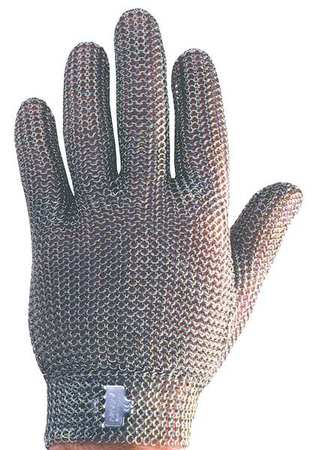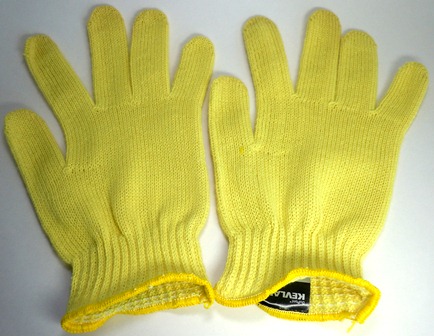 Cut resistant gloves
Cut resistant gloves
 Wear gloves when and where a reasonable chance exists of
your hands contacting something sharp enough to cause a cut.
The hazard assessment should indicate cases where cut-resistant gloves are required.
These gloves are good for handling glass sheet or tubing with sharp edges, broken glass, ceranic, sheet metal,
machined parts with sharp edges, or using knives, razor blades, hand saws, etc.
Cut resistant gloves are intended for use with sharp objects
such as knives and they provide little or no protection from puncture injuries.
The use of these gloves requires a tradeoff between loss of dexterity and the probability of being cut
by a sharp object.
Wear gloves when and where a reasonable chance exists of
your hands contacting something sharp enough to cause a cut.
The hazard assessment should indicate cases where cut-resistant gloves are required.
These gloves are good for handling glass sheet or tubing with sharp edges, broken glass, ceranic, sheet metal,
machined parts with sharp edges, or using knives, razor blades, hand saws, etc.
Cut resistant gloves are intended for use with sharp objects
such as knives and they provide little or no protection from puncture injuries.
The use of these gloves requires a tradeoff between loss of dexterity and the probability of being cut
by a sharp object.
 It is necessary that the gloves you choose
are adequate to protect you from the anticipated hazards.
Keep in mind that gloves are not intended for contact with powered blades.
They are specially designed to give hands the best protection from direct contact with sharp edges
such as glass, metal, ceramics and other materials. Cut resistance is a function of the material composition and thickness of the glove.
You can increase your cut protection by increasing the weight of the material (i.e. ounces per square yard),
using high-performance materials such as Spectra®, Kevlar®, etc., or by using composite yarns made with varying combinations of
fiberglass, stainless steel, and synthetic or high-performance yarns.
With modern engineered materials, thicker is not necessarily better.
In some applications, open fingertip gloves may be used to provide greater dexterity for uses such as inserting small screws.
Cut resistance protects the glove from damage and the wearer from injury.
The ANSI/ISEA 105-2005 standard classifies a glove's cut resistance based on the weight in grams
needed to cut through the material with 25 mm of blade travel.
The chart below defines the levels of cut resistance.
It is necessary that the gloves you choose
are adequate to protect you from the anticipated hazards.
Keep in mind that gloves are not intended for contact with powered blades.
They are specially designed to give hands the best protection from direct contact with sharp edges
such as glass, metal, ceramics and other materials. Cut resistance is a function of the material composition and thickness of the glove.
You can increase your cut protection by increasing the weight of the material (i.e. ounces per square yard),
using high-performance materials such as Spectra®, Kevlar®, etc., or by using composite yarns made with varying combinations of
fiberglass, stainless steel, and synthetic or high-performance yarns.
With modern engineered materials, thicker is not necessarily better.
In some applications, open fingertip gloves may be used to provide greater dexterity for uses such as inserting small screws.
Cut resistance protects the glove from damage and the wearer from injury.
The ANSI/ISEA 105-2005 standard classifies a glove's cut resistance based on the weight in grams
needed to cut through the material with 25 mm of blade travel.
The chart below defines the levels of cut resistance.
| Level |
Weight (grams) |
| 0 |
<200 |
| 1 |
≥200 |
| 2 |
≥500 |
| 3 |
≥1000 |
| 4 |
≥1500 |
| 5 |
≥3500 |
Some commonly used materials shown below include typical cut levels.
The cut level varies for the specific glove so be sure the use the manufacturers rating for the glove you are using.
| Disposable examination gloves: |
These gloves provide essentially no protection.
The material of the disposable glove makes little difference.
Cut level 0. |
| Cotton and Leather: |
provide minimal protection. Cotton (cut level 1) is generally better than leather. |
| Spectra Fiber: |
Ultra-high molecular-weight polyethylene fiber that offers high cut resistance, even when wet.
It is ten times stronger than steel per unit weight.
Cut level 3 to 5. |
| Dyneema: |
Dyneema® Cut Resistant Gloves are made with polyethylene fibers that are 10 to 15 times stronger than steel,
40% stronger than aramid fiber and more durable than polyester.
Cut level 2 to 4. |
| Kevlar®: |
Heat resistant. It is generally a lightweight, flexible material that is used
for various applications relating to glass handling, sheet metal handling and automotive assembly.
Cut level 2 to 3. |
| Fiber-Metal Blends: |
Numerous durable, cut resistant gloves are made of a woven fabric blend of Spectra, Kevlar and stainless steel.
Cut level 4 to 5. |
| Metal Mesh: |
Interlocked stainless steel mesh offers advanced cut and puncture protection due to its superior strength.
Cut level 5. |
| SuperFabric® |
Combinations of the number of layers, substrates, surface coatings, thickness, etc.,
create fabrics which have varying levels of puncture, cut and abrasion resistance, grip and flexibility.
Tactile surface offers enhanced grip of wet and oily surfaces.
Cut level 5. |
  don (put on) gloves and check for flaws, tears, holes.
The gloves should be a comfortable fit, but not so loose that they fall off.
These gloves can be removed (doffed) as you would any pair of gloves.
don (put on) gloves and check for flaws, tears, holes.
The gloves should be a comfortable fit, but not so loose that they fall off.
These gloves can be removed (doffed) as you would any pair of gloves.
 Cut resistant gloves cannot be used to provide protection from powered blades (saws, drills, mills, etc).
Gloves provide little puncture protection.
There are some operations where the dexterity required cannot be achieved with gloves rated for the required level of protedtion.
The use of gloves near powered machenery may result in serious injury if the glove gets caught in moving parts.
Cut resistant gloves cannot be used to provide protection from powered blades (saws, drills, mills, etc).
Gloves provide little puncture protection.
There are some operations where the dexterity required cannot be achieved with gloves rated for the required level of protedtion.
The use of gloves near powered machenery may result in serious injury if the glove gets caught in moving parts.
 All gloves must be inspected before every use, for possible holes, tears,
weak areas.
Gloves should be cleaned after each use if necessary, and stored so that
they may dry inside and out.
Most gloves can be cleaned with soap and water, but it is best to follow the manufacturers instructions if available.
Some gloves such as kevlar may not be cleaned with chlorine bleaches (Chlorox®) but may be cleaned with bleaches like OxiClean®.
The useful life of cut resistant gloves will vary drastically depending on the frequency of use,
the kind of use, and the conditions of cleaning and storage.
Used gloves can be disposed of as regular trash unless they have been contaminated with some hazardous material.
All gloves must be inspected before every use, for possible holes, tears,
weak areas.
Gloves should be cleaned after each use if necessary, and stored so that
they may dry inside and out.
Most gloves can be cleaned with soap and water, but it is best to follow the manufacturers instructions if available.
Some gloves such as kevlar may not be cleaned with chlorine bleaches (Chlorox®) but may be cleaned with bleaches like OxiClean®.
The useful life of cut resistant gloves will vary drastically depending on the frequency of use,
the kind of use, and the conditions of cleaning and storage.
Used gloves can be disposed of as regular trash unless they have been contaminated with some hazardous material.
|






 Cut resistant gloves
Cut resistant gloves